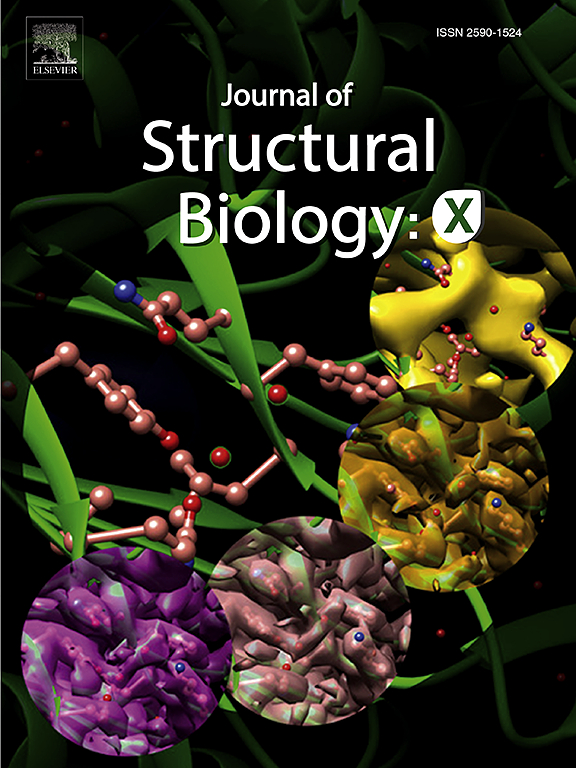Structural insights into human adenylyl cyclase 9 in complex with Gαs by cryo-EM
IF 2.7
3区 生物学
Q3 BIOCHEMISTRY & MOLECULAR BIOLOGY
引用次数: 0
Abstract
Adenylyl cyclase 9 (AC9) regulates many physiologic functions through the production of cAMP, an important second messenger that regulates downstream effectors. The activation of AC9 is highly regulated by GPCR signaling. For example, AC9 is activated by the binding of Gαs, which, in turn, is activated by Gs-driven GPCRs. The structure of bovine AC9 (bAC9) was reported in 2019 using single-particle cryo-electron microscopy (cryo-EM). The structure of human AC9 (hAC9), however, has not been reported to date despite its potential benefit for drug development. Here, we analyzed the structures of hAC9 and hAC9 in complex with Gαs (hAC9-Gαs) using single-particle cryo-EM. The soluble domain of AC9-Gαs, the transmembrane (TM) domain of AC9-Gαs, and AC9 alone were analyzed at resolutions of 2.7 Å, 3.4 Å, and 3.2 Å, respectively. The results revealed three key aspects of the activation mechanism of hAC9 and its cAMP-generating function. First, a conformational change of the soluble domain was observed upon Gαs binding, resulting in a widely open catalytic site. Second, we analyzed the exact position of the C-terminus occluding the catalytic site in the hAC9-Gαs complex. Finally, we unexpectedly identified an elongated density suggestive of a single acyl chain in the TM domain. Consistent with recent reports on the allosteric regulation of AC by lipids, this finding suggests that the TM domain could serve as a potential drug target. These structural findings enhance our understanding of the structure and function of AC9 and other ACs and will provide a foundation for future AC-target drug discovery.

人腺苷酸环化酶9与Gαs复合物的结构分析
腺苷酸环化酶9 (AC9)通过产生cAMP来调节许多生理功能,cAMP是调节下游效应物的重要第二信使。AC9的激活受GPCR信号的高度调控。例如,AC9被g - αs结合激活,而g - αs又被gs驱动的gpcr激活。2019年,利用单粒子冷冻电镜(cryo-EM)报道了牛AC9 (bAC9)的结构。然而,人类AC9 (hAC9)的结构迄今尚未报道,尽管它对药物开发有潜在的益处。本文采用单粒子冷冻电镜分析了hAC9和hAC9与Gαs配合物(hAC9-Gαs)的结构。AC9- g - αs的可溶性结构域、AC9- g - αs的跨膜结构域和单独的AC9分别以2.7 Å、3.4 Å和3.2 Å的分辨率进行分析。结果揭示了hAC9的激活机制及其camp生成功能的三个关键方面。首先,在g - αs结合时观察到可溶性结构域的构象变化,导致催化位点广泛开放。其次,我们分析了hac9 - g - αs络合物中c -末端封闭催化位点的确切位置。最后,我们意外地发现了一个细长的密度,表明在TM结构域中有一个单酰基链。与最近关于脂质对AC变构调节的报道一致,这一发现表明TM结构域可能是一个潜在的药物靶点。这些结构上的发现增强了我们对AC9和其他ac的结构和功能的理解,并将为未来ac靶向药物的发现提供基础。
本文章由计算机程序翻译,如有差异,请以英文原文为准。
求助全文
约1分钟内获得全文
求助全文
来源期刊

Journal of structural biology
生物-生化与分子生物学
CiteScore
6.30
自引率
3.30%
发文量
88
审稿时长
65 days
期刊介绍:
Journal of Structural Biology (JSB) has an open access mirror journal, the Journal of Structural Biology: X (JSBX), sharing the same aims and scope, editorial team, submission system and rigorous peer review. Since both journals share the same editorial system, you may submit your manuscript via either journal homepage. You will be prompted during submission (and revision) to choose in which to publish your article. The editors and reviewers are not aware of the choice you made until the article has been published online. JSB and JSBX publish papers dealing with the structural analysis of living material at every level of organization by all methods that lead to an understanding of biological function in terms of molecular and supermolecular structure.
Techniques covered include:
• Light microscopy including confocal microscopy
• All types of electron microscopy
• X-ray diffraction
• Nuclear magnetic resonance
• Scanning force microscopy, scanning probe microscopy, and tunneling microscopy
• Digital image processing
• Computational insights into structure
 求助内容:
求助内容: 应助结果提醒方式:
应助结果提醒方式:


